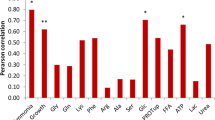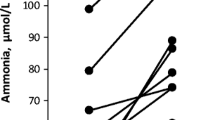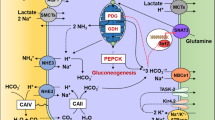Summary
Hepatic and renal nitrogen metabolism are linked by an interorgan glutamine flux, coupling both renal ammoniagenesis and hepatic ureogenesis to systemic acid base regulation. This is because protein breakdown produces equimolar amounts of NH +4 and HCO −3 . A hepatic role in this interorgan team effort is based upon the tissuespecific presence of urea synthesis, which represents a major irreversible pathway for removal of metabolically generated bicarbonate. A sensitive and complex control of bicarbonate disposal via ureogenesis by the extracellular acid-base status creates a feed-back control loop between the acidbase status and the rate of bicarbonate elimination. This bicarbonate-homeostatic mechanism operates without threat of hyperammonemia, because a sophisticated structural and functional organisation of ammonia-metabolizing pathways in the liver acinus uncouples urea synthesis from the vital need to eliminate potentially toxic ammonia.
Similar content being viewed by others
References
Atkinson DE, Camien M (1982) The role of urea synthesis in the removal of metabolic bicarbonate and the regulation of blood pH. Curr Top Cell Reg 21:261–302
Atkinson DE, Bourke E (1984) The role of ureagenesis in pH homeostasis. Trends Biochem Sci 9:297–300
Brosnan JT, Vinay P, Gougoux A, Halperin ML (1988) Renal ammonium production and its implications for acidbase balance. In: Häussinger D (ed) pH homeostasis. Academic Press, New York London, pp 281–304
Cooper AJ, Nieves E, Coleman AE, Filc-DeRicco S, Gelbard A (1987) Short-term metabolic fate of [13N]ammonia in rat liver in vivo. J Biol Chem 262:1073–1080
Dodgson SJ, Forster RE, Storey BT, Mela L (1980) Mitochondrial carbonic anhydrase. Proc Natl Acad Sci 77:5562–5566
Gaasbeek-Janzen JW, Lamers WH, Moorman AFM, De Graaf A, Los AJ, Charles R (1984) Immunohistochemical localization of carbamoylphosphate synthetase (ammonia) in adult rat liver. J Histochem Cytochem 32:557–564
Gebhardt R, Mecke D (1983) Heterogeneous distribution of glutamine synthetase among rat liver parenchymal cells in situ and in primary cultures. EMBO J 3:567–570
Gebhardt R, Ebert A, Bauer G (1988) Heterogeneous expression of glutamine synthetase mRNA in rat liver parenchyma by in situ hybridisation and Northern blot analysis of RNA from periportal and perivenous hepatocytes. FEBS Lett 241:89–93
Gerok W, Häussinger D (1987) Neukonzeption der systemischen Säurebasenregulation — die Bedeutung der Leber. Internist 27:429–436
Guder W, Häussinger D, Gerok W (1987) Renal and hepatic nitrogen metabolism in systemic acid base regulation. J Clin Chem Clin Biochem 25:457–466
Häussinger D (1983) Hepatocyte heterogeneity in glutamine and ammonia metabolism and the role of an intercellular glutamine cycle during ureagenesis in perfused rat liver. Eur J Biochem 133:269–274
Häussinger D (ed) (1988) pH homeostasis. Academic Press, New York London
Häussinger D (1990) Nitrogen metabolism in liver: structural and functional organization and physiological relevance. Biochem J 267:281–290
Häussinger D, Gerok W, Sies H (1984) Hepatic role in pH regulation: role of the intercellular glutamine cycle. Trends Biochem Sci 9:300–302
Häussinger D, Gerok W (1984) Hepatocyte heterogeneity in ammonia metabolism: impairment of glutamine synthetase in CCl4-induced liver cell necrosis with no effect on urea synthesis. Chem Biol Interact 48:191–194
Häussinger D, Gerok W (1985) Hepatic urea synthesis and pH regulation: role of CO2, HCO −3 , pH and the activity of carbonic anhydrase. Eur J Biochem 152:381–386
Häussinger D, Kaiser S, Stehle T, Gerok W (1986) Liver carbonic anhydrase and urea synthesis: the effect of diuretics. Biochem Pharmacol 35:3317–3322
Häussinger D, Gerok W, Sies H (1986) The effect of urea synthesis on extracellular pH in isolated perfused rat liver. Biochem J 236:261–265
Häussinger D, Steeb R, Gerok W (1990) Ammonium and bicarbonate homeostasis in chronic liver disease. Klin Wochenschr 68:175–182
Jungermann K, Katz N (1982) Metabolic heterogeneity of liver parenchyma. In: Sies H (ed) Metabolic compartmentation. Academic Press, New York London, pp 411–435
Jungermann K, Katz N (1989) Functional specialization of different hepatocyte populations. Physiol Rev 69:708–764
Kaiser S, Gerok W, Häussinger D (1988) Ammonia and glutamine metabolism in human liver slices: new aspects on the pathogenesis of hyperammonemia in chronic liver disease. Eur J Clin Invest 18:535–542
Mc Givan JD, Bradford NM, Verhoeven AJ, Meijer AJ (1984) Liver glutaminase. In: Häussinger D, Sies H (eds) Glutamine metabolism in mammalian tissues. Springer, Berlin Heidelberg, pp 122–137
Mc Givan JD (1989) Liver glutamine and glutamate metabolism. In: Kvamme E (ed) Glutamine and glutamate in mammals, vol. 1. CRC Press, Boca Raton, Fla, pp 183–202
Moorman AFM, De Boer AJ, Geerts WJC, Zande LVD, Lamers WH, Charles R (1988) Complementary distribution of carbamoylphosphate synthetase (ammonia) and glutamine synthetase in rat liver acinus is regulated at a pretranslational level. J Histochem Cytochem 36:751–755
Smith DD, Campbell JW (1988) Distribution of glutamine synthetase and carbamoylphosphate synthetase I in vertebrate liver. Proc Natl Acad Sci 85:160–164
Traber PG, Chianale J, Gumucio JJ (1988) Physiologic significance and regulation of hepatocellular heterogeneity. Gastroenterology 95:30–43
Watford M, Smith EM (1990) Distribution of hepatic glutaminase activity and mRNA in perivenous and periportal rat hepatocytes. Biochem J 267:265–267
Author information
Authors and Affiliations
Rights and permissions
About this article
Cite this article
Häussinger, D. Organization of hepatic nitrogen metabolism and its relation to acid-base homeostasis. Klin Wochenschr 68, 1096–1101 (1990). https://doi.org/10.1007/BF01798059
Issue Date:
DOI: https://doi.org/10.1007/BF01798059




